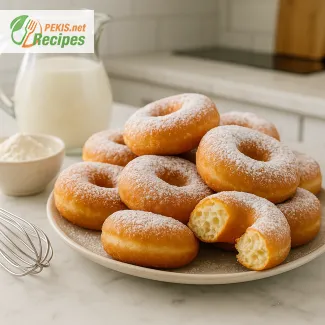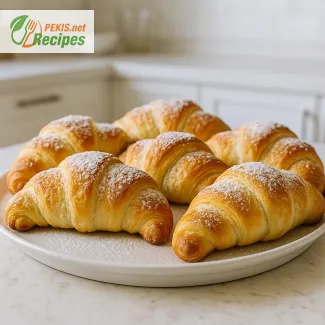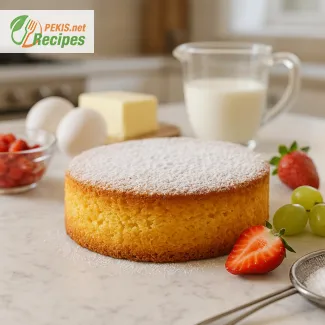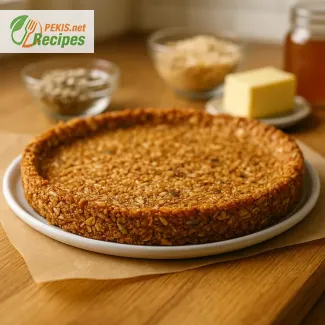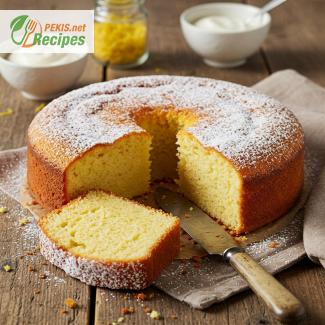
Discover the Ultimate Soft and Moist Yogurt Dessert
Why This Yogurt-Based Cake Will Become Your New Favorite
There’s something incredibly comforting about a simple homemade cake—especially one that delivers on both texture and flavor without requiring advanced baking skills. This easy yogurt cake recipe is the kind of dessert that fits perfectly into any occasion: a lazy Sunday afternoon, an elegant tea gathering, or even a last-minute treat for unexpected guests. With its tender crumb, light tang from the yogurt, and subtle sweetness, it quickly earns its place among family favorites.
Unlike elaborate layer cakes or pastries that demand hours of preparation and intricate techniques, this yogurt cake brings joy through simplicity. It’s a no-fuss, one-bowl cake that comes together effortlessly yet tastes as if you’ve spent the entire afternoon baking. The star ingredient, plain yogurt, not only contributes to the cake's moistness but also gives it a delightful, slightly tangy undertone that elevates the overall flavor profile.
A Classic Dessert with European Roots
This cake has deep roots in European home baking traditions. In countries like France, Italy, and Greece, yogurt cake is often the very first cake children learn to bake. The ingredients are humble and accessible—eggs, flour, yogurt, sugar, and oil—but the result is a beautifully soft, fluffy cake with a golden crust and delicate interior. It’s the kind of recipe that has been passed down through generations, often with handwritten notes and a few personal twists along the way.
The appeal lies not just in its taste, but in its versatility. It can be dressed up with fresh berries, a dusting of powdered sugar, or a dollop of whipped cream. You might also add a touch of lemon zest, vanilla extract, or even chocolate chips to personalize it. Whether you enjoy it as a light dessert, a sweet breakfast, or a teatime companion, this yogurt cake adapts seamlessly to your needs.
Light Yet Rich: The Perfect Balance
What makes this cake particularly special is its unique texture—airy yet moist, light but never dry. Yogurt contributes fat and acidity to the batter, both of which work magic in tenderizing the crumb. Unlike cakes made with heavy cream or butter, this version feels refreshing and light on the palate, making it suitable even after a hearty meal.
Another benefit of yogurt is that it helps the cake stay fresh for longer. You’ll notice that this cake maintains its moisture for several days when stored properly, making it an excellent choice for meal prep or make-ahead desserts. It also holds up well for picnics or road trips, since it doesn’t need refrigeration and resists becoming stale or crumbly.
A Reliable Go-To Recipe for All Skill Levels
If you’re new to baking or looking for a reliable go-to cake, this recipe is ideal. There’s no need for fancy mixers or complicated steps—just basic ingredients and a simple mixing method. The batter is incredibly forgiving, allowing room for experimentation or substitutions if needed.
In fact, many home bakers find themselves returning to this recipe again and again, tweaking it slightly each time depending on what they have in their pantry. Some add crushed nuts for texture, others swirl in fruit preserves for a burst of flavor. No matter how you choose to enjoy it, this yogurt cake proves that delicious results don’t require complicated techniques.
Perfect for Breakfast, Dessert, or Anytime in Between
One of the best things about this cake is how well it fits into different parts of the day. Serve it plain with coffee in the morning, enjoy a slice in the afternoon with tea, or top it with your favorite glaze or compote for an after-dinner treat. Its subtle sweetness and light structure make it suitable for both casual snacking and more formal entertaining.
With its inviting aroma, soft crumb, and delicate tang, this cake brings a touch of homemade comfort to any setting. Whether you’re baking for loved ones or just treating yourself to a peaceful moment, this yogurt cake is sure to bring smiles and requests for the recipe.
Would you like me to continue with the full recipe, nutritional details, and step-by-step preparation?
- Preheat your oven to 180°C (350°F). Grease a standard loaf pan or line it with parchment paper.
- In a large mixing bowl, whisk the eggs and sugar until the mixture becomes pale and slightly frothy.
- Add the yogurt and vanilla extract to the mixture. Whisk until fully incorporated.
- Slowly pour in the sunflower oil while continuously whisking until smooth.
- In a separate bowl, sift together the flour, baking powder, and salt. Gradually fold the dry ingredients into the wet mixture using a spatula or whisk. Mix gently to avoid overmixing.
- If using, stir in the lemon zest for a fresh aroma and added flavor.
- Pour the batter into the prepared pan and smooth the top with a spatula.
- Bake in the center of the preheated oven for 35 minutes or until a toothpick inserted into the center comes out clean.
- Let the cake cool in the pan for 10 minutes before transferring it to a wire rack to cool completely.
- Serve as is, or dust with powdered sugar or a light lemon glaze if desired.
Transforming a Classic: Creative Twists on the Traditional Yogurt Cake
Tips and Ingredient Swaps to Elevate the Flavor and Texture
A traditional yogurt cake is beloved for its simplicity and reliable results, but with just a few thoughtful modifications, you can enhance both its flavor and nutritional profile. Whether you're an experienced baker or a curious home cook, there are countless ways to refine the recipe while staying true to its comforting roots.
Adding Layers of Flavor Without Complication
The classic yogurt cake recipe uses ingredients that are widely accessible: yogurt, flour, sugar, eggs, and oil. These ingredients provide a neutral foundation, making it ideal for flavor enhancements. To boost the aroma and complexity of your cake, consider adding a few drops of almond extract, orange blossom water, or rose water in place of—or in addition to—vanilla extract. These flavors bring a delicate perfume to the crumb without overwhelming the balance of the cake.
Incorporating citrus zest, such as lemon, lime, or orange, also dramatically lifts the overall flavor. Not only does it introduce a fresh and tangy edge, but it complements the yogurt's natural acidity. Always use freshly grated zest to avoid bitterness, and ensure it’s evenly distributed in the batter.
Playing with Texture: From Smooth to Crunchy
To introduce more texture and richness, you can fold in crushed nuts like almonds, walnuts, or pistachios. Toasting the nuts beforehand intensifies their aroma and gives a satisfying crunch in contrast to the soft cake interior. For a juicy, fruity variation, gently fold in fresh blueberries, raspberries, or chopped apples. Lightly coat the fruit with flour before mixing them in to prevent them from sinking during baking.
You might also swirl fruit preserves such as apricot or raspberry jam into the batter just before baking. This not only adds a touch of natural sweetness but creates beautiful ribbons of color and flavor throughout the cake.
Healthier Substitutions for a More Nutritious Cake
While the original recipe is relatively simple, there are several ways to make it more nutrient-dense without sacrificing taste or texture. For example:
- Replace part of the all-purpose flour with whole wheat flour (about 30–50%) to increase fiber and add a nutty depth.
- Use Greek yogurt instead of plain yogurt for a boost in protein and a richer mouthfeel.
- Substitute sunflower oil with extra-virgin olive oil for added antioxidants and a subtle savory note.
- Reduce sugar by 20–25% and balance with a few tablespoons of honey or maple syrup for natural sweetness.
Each of these adjustments slightly alters the final result, offering a more wholesome take on a traditional dessert.
Avoiding Common Pitfalls in Yogurt Cake Baking
Despite being beginner-friendly, yogurt cake still has its share of potential mistakes. Understanding these can help ensure a consistently successful outcome every time.
- Overmixing the batter: This is a common issue that can lead to a dense and tough cake. Mix only until the ingredients are just combined.
- Using cold ingredients: Cold eggs or yogurt can cause the batter to curdle or bake unevenly. Always bring your ingredients to room temperature before starting.
- Incorrect oven temperature: Baking at too high a heat may result in a burnt crust and undercooked center. An oven thermometer is essential to maintain even heat distribution.
- Opening the oven door too early: This sudden change in temperature can cause the cake to sink in the middle. Wait until at least 30 minutes have passed before checking.
Why Homemade Is Always Better
Store-bought cakes might be convenient, but homemade yogurt cake offers unmatched freshness, flavor, and control over ingredients. You can select high-quality yogurt, organic eggs, or even seasonal additions like local berries. The satisfaction of creating something from scratch—especially something so moist, tender, and flavorful—makes every bite more rewarding.
Additionally, baking at home allows you to customize the recipe for dietary preferences or restrictions. It’s easy to prepare a gluten-free or dairy-free version when you have control over every component.
Infusing the Cake with Seasonal Flair
Tailoring your yogurt cake to the seasons is a creative way to keep the recipe fresh year-round. In the summer, try adding crushed peaches, cherries, or even a swirl of lemon curd. During autumn, mix in cinnamon, nutmeg, or cardamom and fold in grated pears or apples. For winter warmth, pair cranberries with a hint of orange zest and top with a light glaze of citrus juice and powdered sugar.
You can also create a layered yogurt cake by slicing the baked cake in half and spreading it with mascarpone, Greek yogurt cream, or fruit compote before reassembling. This gives a luxurious feel with minimal effort.
Making It Your Signature Dessert
A well-loved recipe becomes special when it carries your own personal twist. Whether you like it zesty, nutty, subtly sweet, or rich and decadent, the yogurt cake provides a reliable canvas for creativity. Keep a journal of your adjustments—such as quantities, baking times, and flavors used—so that over time, you develop a version that is uniquely yours.
From morning coffee to afternoon tea or dessert after dinner, an upgraded yogurt cake is an easy way to share warmth and indulgence. Thoughtful ingredient swaps and baking techniques allow you to transform this traditional favorite into a showstopping centerpiece—or keep it humble and homey, just the way it’s meant to be.
- Eggs
- Gluten (from wheat flour)
- Potential traces of nuts or dairy depending on yogurt source
Gluten-free alternative:
Replace all-purpose flour with a gluten-free 1:1 baking flour mix. Check that baking powder is gluten-free.
Egg-free alternative:
Use 120 g (½ cup) of unsweetened applesauce or 2 tbsp ground flaxseeds mixed with 6 tbsp water (let sit for 5 min) as a replacement for eggs.
Dairy-free alternative:
Use plant-based yogurt (soy or coconut) in the same quantity.
- Vitamin A: 80 µg – supports vision and immune function
- Vitamin B2 (Riboflavin): 0.2 mg – important for energy metabolism
- Vitamin D: 0.5 µg – contributes to calcium absorption and bone health
- Calcium: 80 mg – essential for bones and teeth
- Iron: 1 mg – supports oxygen transport in the blood
- Magnesium: 12 mg – helps regulate muscle and nerve function
- Phosphorus: 95 mg – aids in energy production
- Zinc: 0.5 mg – supports immune function and wound healing
- Polyphenols (from lemon zest and yogurt): ~50 mg – contribute to reduced inflammation and cellular protection
- Vitamin C (from lemon zest): ~2 mg – supports immune system and skin health
- Beta-carotene (if eggs from corn-fed hens): ~30 µg – promotes healthy skin and eyesight
